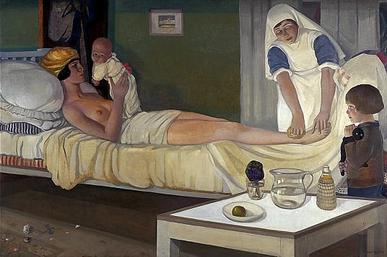At last a lady. AND WHAT LADY?
Cecile Walton
(1891 - 1956)
This painting shows the artist as the mother, holding up the newborn baby. She gazes with solemn adoration and wonderment, the other child looks on with a serious look of deep thought at the changes taking place. This is a very 1920's treatment. Cecile Walton was a wonderful illustrator.

Romance - 1920
.................................................................................
Cecile Walton (29 March 1891 – 23 April 1956), was a Scottish painter, illustrator and sculptor. She and her husband Eric were two of the moving spirits of the Edinburgh chapter of the Symbolist movement in the early 20th century.
She was born in Glasgow, the daughter of the artists Helen and Edward Arthur Walton. At an early age her family moved to London, where she began her art studies. She also attended the Edinburgh College of Art, the Académie de la Grande Chaumière and spent some time in Florence. Against her parents' advice, she married her fellow Edinburgh student, Eric Harald Macbeth Robertson (1887-1941) in 1914. Eric had abandoned architecture and turned to art. He was described as “one of the most brilliant art students of his period”. They had two sons, the first, Gavril, born in February 1915 and the second, Edward, in December 1919.
Eric, Cecile and the painter Dorothy Johnstone (1892-1980) had formed a close painting and physical liaison, but Eric's excessive drinking led in 1923 to the collapse of the trio and Cecile's moving in with Dorothy. Her painting career foundered with their marriage, and she turned to the theatre and working for BBC radio. Eric's career also collapsed after their separation, and he eventually succumbed to alcohol.[1]
She is best known for her ironic self-portrait Romance, in which she depicts herself as a latter-day Olympia, critically inspecting her younger son.